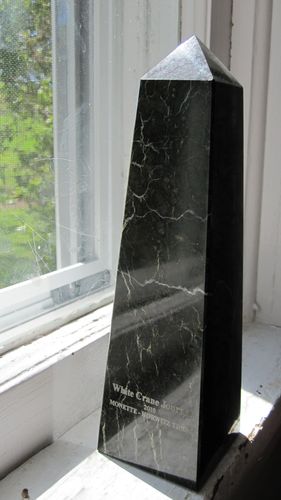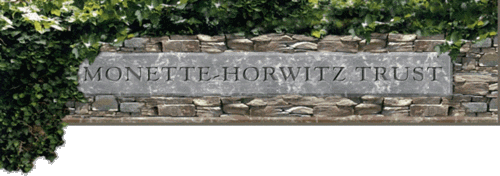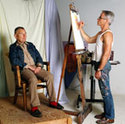With thanks to the trustees of the Monette-Horwitz Trust
Category Archives: The Magazine
The Monette-Horwitz Trust Award
We're pleased to announce…heck, we're tickled pink…that White Crane has been honored by The Monette-Horwitz Trust with their 2010 award. Along with co-honoree, RFD, White Crane is acknowledged by the Trust as reader-written-and-produced
quarterlies celebrating queer diversity. White Crane is celebrating 20 years of publishing; RFD is celebrating 35 years.
Other honorees this year include activist and author, Leslie Feinberg, the oral history film project Impact Stories, the civil rights group Iraq LGBTQ, the Reverend Eric P. Lee, President of the Los Angeles Chapter of the Southern Christian Leadership Conference, the Indian NGO AIDS care organization The NAZ Foundation.
The Trust has been presenting these awards for the past twelve years.
We're pleased and honored to be in such company.
Writer, Paul Monette and his lover, attorney Roger Horwitz, moved from Boston to Los Angeles in 1977. Both men were strongly associated with the LGBT activities of that city until their deaths. Horwitz succumbed to HIV-AIDS in 1896, which inspired Monette to write his groundbreaking memoir, Borrowed Time (1988). Monette went on to win the National Book Award for Becoming A Man: Half A Life Story (1992) and dedicated himself to the writing and activism for which he will remain known, capturing in poetry, prose and public speaking the hopes dreams and rage of a generation of gay men.
Jesse’s Journal — In Praise of Books
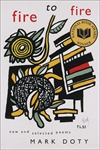 were recently married in Massachusetts. Like Augusten Burroughs’s memoirs, and David Sedaris’s humor, Mark Doty’s poetry appeals to all readers regardless of sexual orientation. Needless to say, it is a great distinction for an out Gay poet to be honored, not as an "American Gay poet," but as an American poet, period. Doty’s honor was well-deserved. (He is, by the way, also the judge for the 2008 White Crane James White Poetry Prize, the winner of which will be announced in the spring issue of White Crane.)
were recently married in Massachusetts. Like Augusten Burroughs’s memoirs, and David Sedaris’s humor, Mark Doty’s poetry appeals to all readers regardless of sexual orientation. Needless to say, it is a great distinction for an out Gay poet to be honored, not as an "American Gay poet," but as an American poet, period. Doty’s honor was well-deserved. (He is, by the way, also the judge for the 2008 White Crane James White Poetry Prize, the winner of which will be announced in the spring issue of White Crane.)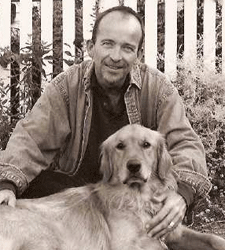 Doty’s NBA acceptance speech was one of the most inspirational I have seen or heard in quite a while. Unfortunately, I had to go to the National Book Awards Web sit to see and hear Doty’s acceptance speech, and those of the other NBA winners. That is because, unlike awards ceremonies honoring movies, recorded music, television or theater, literary awards are never televised, except perhaps on C-SPAN (which, as the saying goes, “nobody watches”). The fact that literary awards are almost never televised is an indication of literature’s low standing in modern American society, gay or straight. While the major networks know that broadcasting the Oscars, the Grammys, the Emmys or the Tonys will win them large audiences, televising the National Book Awards would almost certainly be a ratings disaster and, even worse, drive away the advertisers.
Doty’s NBA acceptance speech was one of the most inspirational I have seen or heard in quite a while. Unfortunately, I had to go to the National Book Awards Web sit to see and hear Doty’s acceptance speech, and those of the other NBA winners. That is because, unlike awards ceremonies honoring movies, recorded music, television or theater, literary awards are never televised, except perhaps on C-SPAN (which, as the saying goes, “nobody watches”). The fact that literary awards are almost never televised is an indication of literature’s low standing in modern American society, gay or straight. While the major networks know that broadcasting the Oscars, the Grammys, the Emmys or the Tonys will win them large audiences, televising the National Book Awards would almost certainly be a ratings disaster and, even worse, drive away the advertisers.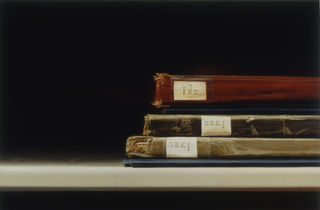 For generations of Gay men, Lesbian women, bisexuals and transgender people, books were an important part of the coming out process. Books like Malcolm Boyd's Take Off the Masks, Radclyffe Hall's The Well of Loneliness, Donald Webster Cory's The Homosexual In America, Christine Jorgensen’s Personal Autobiography, Rita Mae Brown's Rubyfruit Jungle or Patricia Nell Warren's The Front Runner, helped many of us come to terms with our own sexual or gender identity.
For generations of Gay men, Lesbian women, bisexuals and transgender people, books were an important part of the coming out process. Books like Malcolm Boyd's Take Off the Masks, Radclyffe Hall's The Well of Loneliness, Donald Webster Cory's The Homosexual In America, Christine Jorgensen’s Personal Autobiography, Rita Mae Brown's Rubyfruit Jungle or Patricia Nell Warren's The Front Runner, helped many of us come to terms with our own sexual or gender identity. Ink Stained Fingers
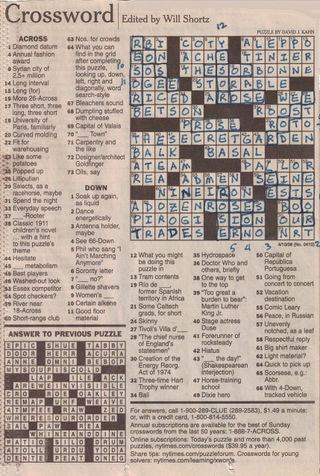
![78cover[1] 1](/wp-content/uploads/2008/12/6a00d8345161a069e20105368e903e970b-120wi.jpg) Year end always seems to be the time to reflect and remember and I have been doing a little of that myself, lately. The subject that commands my attention the most, once I've drawn my jaw-gaping attention from the parade of bad economic news and stories of self-centered, over-consuming greed, is "the media" and the very real economic problems that face all media, us included, as the internet (which we obviously use to some advantage ourselves) and the concommitant loss of revenue this means for print media in particular and older media in general.
Year end always seems to be the time to reflect and remember and I have been doing a little of that myself, lately. The subject that commands my attention the most, once I've drawn my jaw-gaping attention from the parade of bad economic news and stories of self-centered, over-consuming greed, is "the media" and the very real economic problems that face all media, us included, as the internet (which we obviously use to some advantage ourselves) and the concommitant loss of revenue this means for print media in particular and older media in general.
Most mornings I sit with my coffee and my New York Times and scan the pages, usually starting with the obits…the Irish Sports Pages, as my grandmother would call them…the headlines, letters to the editor, the business section, the show biz stories, and finally, folding my C-section — the location of the holy, the beloved crossword puzzle that I have worked every day for the past 32+ years — into the now reduced (since the Times has cut the size of their pages) quarterfold.
Early in the week I knock that off even before I go off to work; from Thursday on, I carry it with me through the day as my companion for the down moment, the inbetween transit from place-to-place, lest I be caught with nothing to do but stare into space. It is finished, of course, every day. Always in pen, and with specifically prescribed lettering…capital letters only. And no…I don't want any help, thank you very much. The crossword is my own personal pleasure. It is a meditation and I do that alone. I am often told, when I complain that a New York Times is unavailable to me as I travel, that the puzzle…my puzzle…is available on line and I just have to give the benighted person a smile and, controlling my urge to laugh in their face, simply explain that, "No, it's just not the same."
Now, we are told, people get their news here…on line…and are no longer going to print media as much, causing many of the old gray newspapers, in many a city to not just fold into quarters, but fold altogether  and disappear. Worse, the newspapers that tend to remain are "NewsLite McPapers" with graphs and four color illustrations (you know who you are!) that take give predigested, reader's digest compendiums of "news" that, rather than connecting the reader with his community, tending to put it all at a sanitized distance when it isn't using "news" to scare us all into stupor or submission.
and disappear. Worse, the newspapers that tend to remain are "NewsLite McPapers" with graphs and four color illustrations (you know who you are!) that take give predigested, reader's digest compendiums of "news" that, rather than connecting the reader with his community, tending to put it all at a sanitized distance when it isn't using "news" to scare us all into stupor or submission.
This is a serious problem I think…and I don't care if I am showing my age by saying so. I can't imagine my world without that moment of solitude with newsprint in the morning, the cat stalking me behind the curtain of paper, attacking the corners of the section I'm reading and demanding attention.
 Of course, I am also a publisher of a magazine and, again, people often ask me, when I explain how the costs of publishing have continued to climb, making the production of White Crane more and more costly to produce…they ask me "have you ever considered just doing it on line?"…and of course, we do publish a portion of every issue on line. And, again, controlling my urge to laugh in their face, I patiently explain.."No. It's just not the same."
Of course, I am also a publisher of a magazine and, again, people often ask me, when I explain how the costs of publishing have continued to climb, making the production of White Crane more and more costly to produce…they ask me "have you ever considered just doing it on line?"…and of course, we do publish a portion of every issue on line. And, again, controlling my urge to laugh in their face, I patiently explain.."No. It's just not the same."
If there is anyway that we will be able to continue to produce the "hard copy" as it is now referred to, I swear we will. In my heart, to say nothing of my head, there is something critically important about the creation of an actual document, something tangible that you hold in your hands…something that university and municipal libraries collect and bind into leather bindings. Especially for Gay material…and by Gay material, with all due respect for populism, I do not mean OUT magazine, or The Advocate…but I do mean publications like our own and the Gay & Lesbian Review … as examples.
I'm not saying there isn't a place for popular entertainment. I like and need my fluff as much as the next person (though I really don't care what Paris Hilton is up to…ever.) But beyond that, and somewhere in between that and the fussy papers of academia, there has to be a place for the writings of a community that is still trying to come to terms with itself. And do so in some way other than simply trying to "fit in," assimilate and not cause waves. When I came out 35 years ago, the only place I could find any reference to myself was in the dictionary, under "homosexual"…and a sorry definition it was, too. It is important that some young person, going to their bookstore, or a library find something other than that…see themselves in print and be able to hold onto it for a moment…for as long as they need to hold on to it.
I know the same wringing of hands went on when television came along…and probably when radio arrived…about the loss of something valuable in the glare of something new. Television was going to kill radio. And didn't. The internet is going to kill newspapers. And it won't. Radio still manages to remain relevant and though even I have bought a Kindle (I carried 47 books on the plane with me this past weekend…could have carried more than 2000 if I wanted…no bookshelves to dust, either)…nevertheless I will always buy hardcover books. I might become more selective about what I buy and what I want to care for and store. But I will still buy them.
And so it is with the newspaper and magazine. You will never catch me doing my NY Times crossword on my Kindle…even though it is available on it, every day, for less than I pay to have it delivered to my front door (in the blue plastic bag that is immediately recycled into dog poop duty!…what would I do with out that!?) It just isn't the same thing. My fingers will always be stained with the ink of the C-section, and there will always be a pen in my pocket to do the puzzle.
And we will always publish White Crane if I have anything to say about it. And you will be able to hold it in your hands, and save it on a shelf, and take it down and reread it and share it with your friends and family and community.
As we enter our twentieth year of publishing…we promise you that.
It’s an honor just to be…
Well, well, well…this humble blog, powered by Typepad, has been selected as one of the "Featured Blogs of the Month" along with none other than Andrew Sullivan. Check us out…here. We’re just after "Petopia" and just before "Gaia’s Horse." Nice company.
Chris & Don
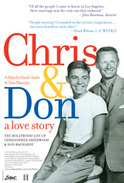 I’m excited about this new documentary, Chris & Don: A Love Story that is opening here in New York (and I’m guessing in Los Angeles, for the time being.)
I’m excited about this new documentary, Chris & Don: A Love Story that is opening here in New York (and I’m guessing in Los Angeles, for the time being.)
White Crane had a marvelous interview with Don Bachardy not too long ago. And I have the delightful experience of sitting for a series of portraits of myself by Don Bachardy (seen at the right.)
What a marvelous film…more love story than documentary. Charming, moving, fascinating. Every Gay person should see this beautiful story of two loving men who were out when out was truly a courageous act, even in Hollywood. Narrated by actor Michael York, this is just a terrific piece.
I think one of the most moving stories the film relates is how, in the last months of Isherwood’s life, as he was dying from prostate cancer, Bachardy diligently, devotedly painted portrait after portrait of his dying lover. Recorded in the breathtaking, beautiful (and rare) book, Last Drawings of Christopher Isherwood (with an appreciation by none other than Stephen Spender), their mutual devotion to his lover was turned into art.
Ancestors Issue Online
 Excerpts from the Spring issue of White Crane are now up online.
Excerpts from the Spring issue of White Crane are now up online.
The topic for the issue was "Ancestors" and featured a cover I’m particularly proud of. It features the portraits of a number of Gay and proto-Gay writers and activists from the past — now "ancestors" of course.
The issue includes a real mix of submissions from our writers and two interviews with folks we were fascinated with. There’s one interview with Steven Solberg, who’s working on a documentary about Gay Elders and Aging and an interview with former Clinton gay friend and politico David Mixner (who endorsed Obama this year).
Subscribers should be receiving their copies in the next few days.
Read excerpts here.
Ancestors – One and the Supremes
January 15th is a red letter date in GLBT history, and particularly in the history of Gay publishing (blogger Jim Burroway has a very nice remembrance of this at Box Turtle) and in light of the recent passing of Mattachine assimilationist, Kennith H. Burns in Los Angeles it seems even more trenchant.
Fifty years ago, a Supreme Court unsullied by religion and right-wing fundamentalism ruled in One Inc. v Oleson that a magazine for Gays and Lesbians could be sent through the mail and not be seized as pornography, per se. To be entirely accurate, One Inc. v. Oleson was on the docket for the Court when they decided Roth v. United States, which vaguely held that "pornography" could have "no sociably redeeming value" and the court went on to issue a one sentence per curiam i.e. "by the court" with no assigned findings included, — much as Gore v. Bush was decided, incidentally — that the lower court ruling against One Inc. was inconsistent with Roth so it could, indeed, be published and mailed.
Under the editorial leadership of Martin Block, Dale Jennings, Don Slater and Donald Webster Cory, ONE magazine was a first class product, a dramatic departure from the underground, mimeographed and stapled sheets which were more common at the time. In the throes of McCarthyism, the sophisticated and slickly produced one reached the astounding readership of 2,000 (more, sad to say, than this magazine reaches, now, 50 years later).
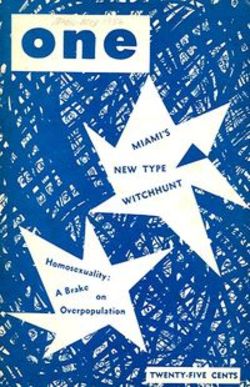 ONE’s tone was bold and unapologetic, covering politics, civil rights, legal issues, police harassment (which was particularly harsh in One’s hometown of Los Angeles), employment and familial problems, and other social, philosophical, historical and psychological topics. Most importantly, ONE quickly became a voice for thousands of silent gays and lesbians across the U.S., many of whom wrote letters of deep gratitude to ONE’s editors.
ONE’s tone was bold and unapologetic, covering politics, civil rights, legal issues, police harassment (which was particularly harsh in One’s hometown of Los Angeles), employment and familial problems, and other social, philosophical, historical and psychological topics. Most importantly, ONE quickly became a voice for thousands of silent gays and lesbians across the U.S., many of whom wrote letters of deep gratitude to ONE’s editors.
Other founders were Merton Bird, W. Dorr Legg, and Chuck Rowland. Jennings and Rowland were also Mattachine Society founders.
In January 1953 ONE, Inc. began publishing ONE Magazine, the first U.S. pro-gay publication, and sold it openly on the streets of Los Angeles. In October 1954 the U.S. Postal Service declared the magazine ‘obscene’. ONE sued, and finally won in 1958, as part of the landmark First Amendment case, Roth v. United States. The magazine continued until 1967.
ONE also published ONE Institute Quarterly (now the Journal of Homosexuality). It began to run symposia, and contributed greatly to scholarship on the subject of same-sex love (then called "homophile studies").
ONE readily included women, and Joan Corbin (as Eve Elloree), Irma Wolf (as Ann Carrl Reid), Stella Rush (as Sten Russell), Helen Sandoz (as Helen Sanders), and Betty Perdue (as Geraldine Jackson) were vital to its early success. ONE and Mattachine in turn provided vital help to the Daughters of Bilitis in the launching of their newsletter The Ladder: a lesbian review in 1956. The Daughters of Bilitis was the counterpart lesbian organisation to the Mattachine Society, and the organisations worked together on some campaigns and ran lecture-series. Bilitis came under vicious attack in the early 1970s for ‘siding’ with Mattachine and ONE, rather than with the new separatist feminists.
In 1965, ONE separated over irreconcilable differences between ONE’s business manager Dorr Legg and ONE Magazine editor Don Slater. After a two-year court battle, Dorr Legg’s faction retained the name "ONE, Inc." and Don Slater’s faction retained most of the corporate library and archives. In 1968, Slater’s faction became the Homosexual Information Center, a non-profit corporation that survives today.
In 1996, ONE, Inc. merged with ISHR, the Institute for the Study of Human Resources, a non-profit organization created by transgendered philanthropist Reed Erickson, with ISHR being the surviving organization and ONE being the merging corporation. The organization also merged with Jim Kepner’s International Gay and Lesbian Archives. The current organization entitled the ONE National Gay and Lesbian Archives onearchives.org is the world’s largest gay and lesbian archives. It is located in Los Angeles near the campus of the Uuniversity of Southern California. It holds the archives of ONE Magazine, ONE INC., and many leaders of the early gay movement including Dorr Legg, Pat Rocco, Morris Kight, and the LA Gay Center, as well as numerous audio and video tapes of ONE INC and other early gay panels and programs.
White Crane stands in awe and respect of those who went before us.
Rainbow Radio!
 White Crane was on the radio waves recently. Reader and frequent contributor, Ed Madden, an Associate Professor of English at the University of South Carolina, in Columbia, produces a wonderful community radio program called Rainbow Radio and was kind enough to talk with Dan and me. You can listen to the show here.
White Crane was on the radio waves recently. Reader and frequent contributor, Ed Madden, an Associate Professor of English at the University of South Carolina, in Columbia, produces a wonderful community radio program called Rainbow Radio and was kind enough to talk with Dan and me. You can listen to the show here.
The Learning Curve: An Apology and An Explanation
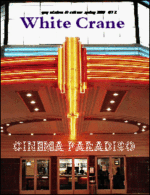 If I recall the phrase correctly it’s "never complain, never explain."
If I recall the phrase correctly it’s "never complain, never explain."
…and whoever said that never published a magazine.
Many of you have been contacting us complaining (rightfully) that you haven’t received the spring issue yet.
That would be because it is two months late.
As I have explained to those who have contacted us, what little hair I have left is now greatly diminished as a result. So here’s what happened:
When last we spoke of this, the printer we had been using since Toby was publisher, in Texas, simply disappeared <POOF!> just before we put out the winter issue, which was also late because of this unforeseen complication.
And as you may also have noticed with the winter issue, we’re looking a lot prettier, a lot sleeker and a lot more colorful. That’s the good part of finding a new printer.
The bad part of finding a new printer is we have a whole set of new specifications and picture formats and guidelines and requirements that we’ve never had before. There’s a reason we’re prettier and sleeker and more colorful. Our newfound sophistication comes at a price.
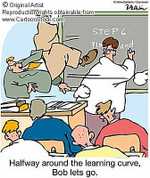 It’s called "a learning curve." And we took this one a little too fast.
It’s called "a learning curve." And we took this one a little too fast.
And, boy…did it throw us for a loop! We really thought we had it down… pictures all in the right format, everything off to the printers in a timely manner. What could possibly go wrong?!
The answer is: Everything and anything.
That’s when we discovered that some of our mail from the printer was being shunted into our spam file. A whole week and a half had gone by before we discovered that the printer wasn’t happy with what we’d sent and we needed to make some changes.
This added yet another few days to the mess…and by the time we got things back to the printers we’d lost our place in the printing line-up. We had to go to the end of the line. Which meant that we had to wait yet another two weeks before the issue was printed…and then another few days to ge t it to the distribution folks. And there you have it.
t it to the distribution folks. And there you have it.
Or you don’t…and as a result, you, our devoted and patient subscribers, haven’t seen the spectacular, cinemascopic issue on Movies with it’s cast of thousands.
Unless, of course, you have…because I am assured that the mailing went out this week and you should have the spring issue, pictured above and excerpted here…soon…very very soon.
And we are very very sorry. We are working to make sure it never happens again. And as an apology, we are extending every subscription by an issue. So if your subscription ended with the Summer issue this year, it will now end with the fall issue…etc.
And thank you for your support….and understanding.
